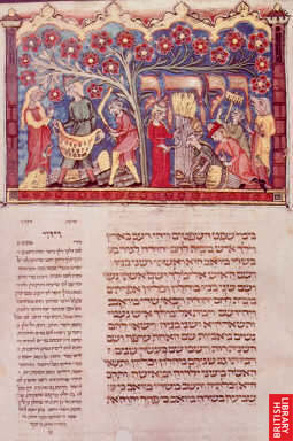Difference between revisions of "Mahzor"
Gattabaissa (talk | contribs) |
Gattabaissa (talk | contribs) |
||
| Line 5: | Line 5: | ||
It was produced in Southern Germany around 1320. Its scribe was a certain Hayyim. | It was produced in Southern Germany around 1320. Its scribe was a certain Hayyim. | ||
| − | Volume I | + | [http://kaufmann.mtak.hu/en/ms384/ms384-coll1.htm Volume I] |
Vellum, 3121,5cm | Vellum, 3121,5cm | ||
It contains the special Sabbaths, Purim, Passover, with Song of Songs and commentary. There are fourteen initial-word panels at the beginning of the prayers and eleven zodiac sign with the labors of the months in medals, and several border decorations. The folio 142 was cut, therefore the sign of the taleh, that is, Aries and labor of Nisan are missing. | It contains the special Sabbaths, Purim, Passover, with Song of Songs and commentary. There are fourteen initial-word panels at the beginning of the prayers and eleven zodiac sign with the labors of the months in medals, and several border decorations. The folio 142 was cut, therefore the sign of the taleh, that is, Aries and labor of Nisan are missing. | ||
| Line 72: | Line 72: | ||
Places of preserving: | Places of preserving: | ||
| − | Volume I: Budapest, MTA Kaufmann Collection, Ms A384 | + | [http://kaufmann.mtak.hu/en/ms384/ms384-coll1.htm Volume I: Budapest, MTA Kaufmann Collection, Ms A384] |
| − | |||
Volume II: London, British Library Add. Ms. 22413 | Volume II: London, British Library Add. Ms. 22413 | ||
Revision as of 18:29, 10 December 2008
Tripartite Mahzor
Description of the manuscripts This is a tripartite Jewish festival prayer book according to the German rite. It was produced in Southern Germany around 1320. Its scribe was a certain Hayyim.
Volume I Vellum, 3121,5cm It contains the special Sabbaths, Purim, Passover, with Song of Songs and commentary. There are fourteen initial-word panels at the beginning of the prayers and eleven zodiac sign with the labors of the months in medals, and several border decorations. The folio 142 was cut, therefore the sign of the taleh, that is, Aries and labor of Nisan are missing.
Volume II Vellum, 31,522cm It contains the Savuot and the Succot with commentary. There are eight initial-word panels at the beginning of the prayers and a zodiac cycle. The scribe’s signature is at the end of the Savuot (fol.80v).
Volume III Vellum, 3424,5cm It contains the first two days of Rosh Hashanah and Yom Kippur. There are nine initial-word panels at the beginning of the prayers.
Animal-headed figures in the three volumes
Volume I
fol.183v The Throne of Solomon, at the beginning of the Song of Songs
fol.197r Crossing the Red Sea, at the beginning of a piyyut belonging to the morning prayer of the seventh day of Pesah
fol.143r Twins, zodiac cycle in the Prayer for Dew, Pesah
Volume II
fol.3v
Receiving the Law, at the beginning of a piyyut belonging to the morning prayer of the first day of Shavuot
fol.71v
two scenes from the Book of Ruth, at the beginning of the Book of Ruth, the second day of Shavuot
fol.85v a bird headed figure stands next to the word, at the beginning of a piyyut belonging to the morning prayer of the first day of Succoth
fol.139v Twins, zodiac cycle in the Prayer for Rain, Shemini Atzeret
The volume III does not contain zoocephalic figures.
Reproductions of the animal-headed images
Vol.I, fol.183v
Narkiss, Bezalel. Hebrew Illuminated Manuscripts. Jerusalem: Keter Publishing House, 1978.
106-7, Pl.33.
and Ormos István. Kaufmann Dávid és gyűjteménye (David Kaufmann and his Collection). Különlenyomat az Örökségünk a múltunk. Gyűjtemények a Magyar Tudományos Akadémia könyvtárában. Budapest: MTA Könyvtára, 2001. 253, fig.13.
Vol.I, fol.143r Ormos István. Kaufmann Dávid és gyűjteménye (David Kaufmann and his Collection). Különlenyomat az Örökségünk a múltunk. Gyűjtemények a Magyar Tudományos Akadémia könyvtárában. Budapest: MTA Könyvtára, 2001. 248, fig.9.
Vol.II, fol.3r Mellinkoff, Ruth. Antisemitic Hate Signs in Hebrew Illuminated Manuscripts from medieval Germany. Jerusalem: Center of Jewish Art–The Hebrew University of Jerusalem, 1999. 88, fig.9.
Vol. II, fol.71r Mellinkoff, Ruth. Antisemitic Hate Signs in Hebrew Illuminated Manuscripts from medieval Germany. Jerusalem: Center of Jewish Art–The Hebrew University of Jerusalem, 1999. 105, fig.302. http://www.imagesonline.bl.uk (I could not attach the exact address)
Documentary notes
Places of preserving:
Volume I: Budapest, MTA Kaufmann Collection, Ms A384 Volume II: London, British Library Add. Ms. 22413
Volume III: Oxford, Bodleian Library Ms. Michael 619
References
Buda,Zsófia. Animals Gazing at Women: Zoozephalic Figures in the Tripartite Mahzor, in: Animal Diversities. Ed. by Gerhard Jaritz and Alice Choyce (Medium Aevum Quoditianum Sonderband 16), Krems 2005, p. 136-166.
Narkiss, Bezalel. Hebrew Illuminated Manuscripts. Jerusalem: Keter Publishing House, 1978.
Narkiss, Bezalel. ”On the Zoocephalic Phenomenon in Medieval Ashkenazi Manuscripts” in: Norms and Variations in Art. Essays in Honour of Moshe Barasch, ? Jerusalem, 1983, 49-62.
Narkiss, Bezalel. ”A Tripartite Illuminated Mahzor from a South German School of Hebrew Illuminated Manuscripts around 1300.” in Fourth World Congress of Jewish Studies Papers, ? Vol. 2, Jerusalem: World Union of Jewish Studies, 1968.
Sharit, Shalev-Eyni. Ha-Mahzor ha-Meshullash (The Tripartite Mahzor). PhD Dissertation.
contributor Buda, Zsófia, m04buz01@student.ceu.hu, Central European University
